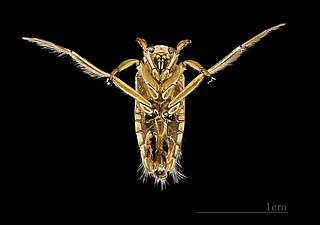
Branchiopoda is a class of crustaceans. It comprises fairy shrimp, clam shrimp, Diplostraca, Notostraca, the Devonian Lepidocaris and possibly the Cambrian Rehbachiella. They are mostly small, freshwater animals that feed on plankton and detritus.

The rotifers, sometimes called wheel animals or wheel animalcules, make up a phylum of microscopic and near-microscopic pseudocoelomate animals.

Daphnia is a genus of small planktonic crustaceans, 0.2–6.0 mm (0.01–0.24 in) in length. Daphnia are members of the order Anomopoda, and are one of the several small aquatic crustaceans commonly called water fleas because their saltatory swimming style resembles the movements of fleas. Daphnia spp. live in various aquatic environments ranging from acidic swamps to freshwater lakes and ponds.
Daphnia jollyi is a species of crustaceans in the genus Daphnia. It is endemic to Western Australia, where it lives in shallow freshwater pools over granite bedrock. Daphnia jollyi is listed as a vulnerable species on the IUCN Red List.
Daphnia occidentalis is a species of crustacean in the family Daphniidae. It is endemic to Australia, and is the only species in the subgenus Australodaphnia.
Korshikoviella is a genus of green algae in the family Characiaceae.

The Diplostraca or Cladocera, commonly known as water fleas, is a superorder of small, mostly freshwater crustaceans, most of which feed on microscopic chunks of organic matter, though some forms are predatory.

Moina is a genus of crustaceans within the family Moinidae. The genus was first described by W. Baird in 1850. They are referred to as water fleas, but are related to the much larger Daphnia magna and the larger Daphnia pulex. This genus demonstrates the ability to survive in waters containing low oxygen levels, high salinity, and other impurities, including salt pans, and commonly eutrophication. An example of such an extreme habitat is the highly saline Makgadikgadi Pans of Botswana, which supports prolific numbers of Moina belli.

Daphniidae is a family of water fleas in the order Anomopoda.

Daphnia pulex is the most common species of water flea. It has a cosmopolitan distribution: the species is found throughout the Americas, Europe, and Australia. It is a model species, and was the first crustacean to have its genome sequenced.

Daphnia magna is a small planktonic crustacean that belongs to the subclass Phyllopoda.
Host–parasite coevolution is a special case of coevolution, where a host and a parasite continually adapt to each other. This can create an evolutionary arms race between them. A more benign possibility is of an evolutionary trade-off between transmission and virulence in the parasite, as if it kills its host too quickly, the parasite will not be able to reproduce either. Another theory, the Red Queen hypothesis, proposes that since both host and parasite have to keep on evolving to keep up with each other, and since sexual reproduction continually creates new combinations of genes, parasitism favours sexual reproduction in the host.

Notonecta maculata is a backswimmer of the family Notonectidae, found in Europe, including the United Kingdom.

Ephippia are winter or dry-season eggs of the various species of small crustacean in the order Cladocera ; they are provided with an extra shell layer, which preserves and protects the resting stages inside from harsh environmental conditions until the more favorable times, such as spring, when the reproductive cycle is able to take place once again. Ephippia are part of the back of a mother carrying them until they are fully developed. After molting, the ephippium stays in the water, or in the soil of dried puddles, small ponds, and vernal pools. The resting stages are often called eggs, but are in fact embryos with arrested development. Ephippia can rest for many years before the embryo resumes development upon an appropriate hatching stimulus.

Ordospora colligata is an intracellular parasite belonging to the Microsporidia. It is an obligatory gut parasite with the crustacean Daphnia magna as its only host. So far it has been reported from Europe and Asia.

Pasteuria ramosa is a gram-positive, endospore-forming bacterium in the Bacillus/Clostridia clade within Bacillota. It is an obligate pathogen of cladoceran crustaceans from the genus Daphnia. Daphnia is a genus of small planktonic crustaceans including D. magna, P. ramosa's most popular host target. Other hosts include D. pulex, D. longispina, D. dentifera, and Moina rectirostris. An established and widely used coevolutionary model of host-pathogen interactions exists with P. ramosa and D. magna.

Hamiltosporidium is a genus of Microsporidia, which are intracellular and unicellular parasites. The genus, proposed by Haag et al. in 2010, contains two species; Hamiltosporidium tvaerminnensis, and Hamiltosporidium magnivora. Both species infect only the crustacean Daphnia magna (Waterflea).

Daphnia pulicaria is a species of freshwater crustaceans found within the genus of Daphnia, which are often called "water fleas," and they are commonly used as model organisms for scientific research. Like other species of Daphnia, they reproduce via cyclic parthenogenesis. D. pulicaria are filter-feeders with a diet primarily consisting of algae, including Ankistrodesmus falcatus, and they can be found in deep lakes located in temperate climates. Furthermore, D. pulicaria are ecologically important herbivorous zooplankton, which help control algal populations and are a source of food for some fish. D. pulicaria are closely related to Daphnia pulex, and numerous studies have investigated the nature and strength of this relationship because these species can produce Daphnia pulex-pulicaria hybrids. In recent years, D. pulicaria along with other Daphnia species have been negatively affected by invasive predators, such as Bythotrephes longimanus.

Dieter Ebert is professor for Zoology and Evolutionary Biology at the Zoological Institute at the University of Basel in Basel, Switzerland. He is an evolutionary ecologist and geneticist, known for his research on host–pathogen interaction and coevolution, mainly using the model system Daphnia and its parasites.
Daphnia studeri is a species of microcrustacean in the genus Daphnia. D. studeri lives in oligotrophic freshwater and slightly brackish lakes in Antarctica and sub-Antarctic islands.














